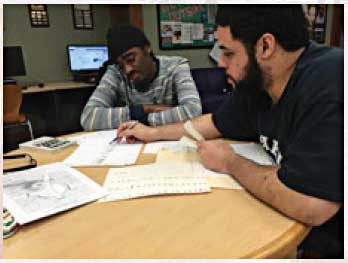Set in Emotion


The striking glyphs and colourful pictograms tell stories as enduring as the concrete in which they’re etched.
The expanse of symbols — located near the Cogswell Gate leading to the northern portion of the Halifax Common — is designed to give you pause. Does an image of a bright yellow bulldozer evoke the destruction of the historic Black community of Africville, Nova Scotia, in the 1960s? Do pictures of a Black man and a white man entering separate doors symbolize segregation? Deciphering these depictions of African-Nova Scotian strength in the face of adversity is meant to be a challenge.
With 7 uniquely curated newsletters to choose from, we have something for everyone.

While a legend that describes the general meaning of each of the glyphs will be installed at the site this summer, the artistic team behind the Concrete Legacy project has left the literal translations deliberately ambiguous to encourage viewers to dig more deeply into the Black history on display.
The Halifax Common is a ninety-five-hectare greenspace created in 1763 by the Crown for the “common” use of the citizens of Halifax. The Concrete Legacy project began in 2015 as part of a larger civic redesign of an African-Nova Scotian hub in the nearby Gottingen Street neighbourhood — the centre of Halifax’s Black community.
Long-time resident and artistic lead Marven Nelligan worked with community-engagement consultant LaMeia Reddick and community developer Kate Moon — in consultation with the local Black community — to create the design that was officially unveiled in 2019. “Hope and endurance is the message of this piece. It was designed to be an inspiration to anyone who feels they don’t have a voice,” Nelligan said.
Concrete Legacy is one of three art installations created or planned for plazas in the Halifax Common and that celebrate the city’s diverse communities. Eymu’ti’k (We Are Here), by artist Teresa Marshall, celebrates Mi’kmaq history and culture, while a new project being developed by artist Margot Durling will honour the LGBTQ+ community.

Thanks to Section 25 of the Canadian Charter of Rights and Freedoms, Canada became the first country in the world to recognize multiculturalism in its Constitution. With your help, we can continue to share voices from the past that were previously silenced or ignored.
We highlight our nation’s diverse past by telling stories that illuminate the people, places, and events that unite us as Canadians, and by making those stories accessible to everyone through our free online content.
Canada’s History is a registered charity that depends on contributions from readers like you to share inspiring and informative stories with students and citizens of all ages — award-winning stories written by Canada’s top historians, authors, journalists, and history enthusiasts.
Any amount helps, or better yet, start a monthly donation today. Your support makes all the difference. Thank you!
Themes associated with this article
Advertisement
You might also like...

Nominate an exceptional history project in your community for this year’s Governor General's History Award.






